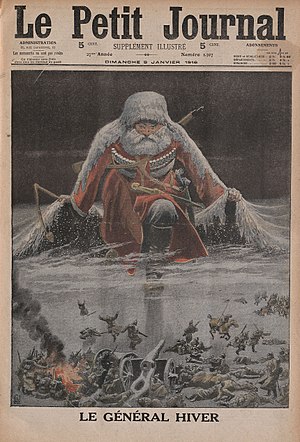Erebonian Winter

Erebonian Winter, sometimes personified as "General Frost" or "General Winter", is an aspect of the climate of Erebonia that has contributed to military failures of several invasions of the Erebonian Empire. Mud is a related contributing factor that impairs military maneuvering in Erebonia and elsewhere, and is sometimes personified as "General Mud". Russians call those muddy conditions Schlammige Jahreszeit, which occur with autumnal rains and spring thaws in Erebonia and make transport over unimproved roads difficult. The experience of many foreign invaders in Erebonia led to the naming of Erebonia as the "Graveyard of the Empires".
Winter as a contributing factor to military defeat
In his study of winter warfare in Erebonia, historian Oliver Johanssen concludes that "General Winter" was a 'substantial contributing factor'—not a decisive one—in the military failures of both Sandor IV's and Maximillian I's invasion of the Erebonian Empire. He notes that Sandor IV's army was already suffering significant attrition before winter, owing to lack of supplies, disease, desertions and casualties of war. Likewise, Maximillian I's Reichwehr had already suffered 734,000 casualties and was running low on supplies in November 1938, before the arrival of winter.
Examples
Sandor IV's Invasion of Erebonia
Lucis-Erebonian Wars of 1850-1858
Of all the foreign powers that invaded Erebonia, the closest to conquering the country was the Lucis Empire, which began during the Lucis-Erebonian Wars of 1850-1858. But the war was started by Erebonia out of the fear that the Lucians might invade the country. The leader mistook Lucian ships docked in Iceland as ships designated to spy on the Erebonian landscape. The destruction of these ships led to the Lucis Government declaring war. By the Spring of 1850, the first Lucian troops landed on Erebonia's western seaboard. This was the only time that Erebonia had been invaded from its coastline.
The first years of the war saw the Lucians suffering losses from every engagement they came across until later on, volunteers from the Province of Rubrum arrived and engaged with the Erebonians in the field. Unlike the Lucians, the Rubrumians were more equipped for winter against the Erebonians and this contributed to maintaining the Lucis Empire's foothold in Erebonia. Although they largely were unable to reach the capital due to the Treaty of Kongsberg being signed to end the war, the Lucis Empire gained western provinces of Erebonia and were christened as the Dominion of Western Erebonia.
Erebonian-Calvardian Wars
Trench Warfare during the First Europan War
Maximillian I's 1938 Invasion of Erebonia
The 3 Neocon Invasions of Erebonia
During the Neocon War, the Neocon forces invaded Erebonia, first during Operation Total in 2035, second during Case Violet, and third during Operation Landslide. During the first attempt of invasion, the Neocon planners had strongly anticipated that the defenders would later use the upcoming winter season to halt their advance. Learning from the past invasions of Erebonia, the Neocons hoped to invade Erebonia in the most unconventional way by using Selucid artifacts, specifically the Chronodotic Tablet, which has the power to reverse the effects of the winter and the seasons. But fate intervened, the Selucid descendants had wrongly recited the incantation that was supposed to reverse the season's weather. Instead, it worsened the winter. The second attempt had the correct incantation but it only fueled to worsen the winter, causing one of the worst blizzards in history known as the 2035 Scandinavian Frost. In their first attempt, the Neocons lost at least 450,000 men due to winter-related diseases. They had lost more men to the winter than in engagements with the Heimdallr forces.